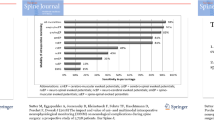Abstract
A prospective study of 1,017 patients who received MIOM during spine surgery procedures between March 2000 and December 2005. To determine the sensitivity and specificity of MIOM techniques used to monitor spinal cord and nerve roots function during spine surgery. MIOM has become a widely used method of monitoring neural function during spine surgery. Several techniques only monitor either ascending or descending pathways and thus may not provide sensitive or specific results. MIOM aims to monitor both ascending and descending pathways therefore giving immediate feedback information regarding any neurological deficits during the operation. Intraoperative sensory spinal and cortical evoked potentials, combined with monitoring of EMG and motor evoked potentials recorded from the spinal cord and muscles elicited by electrical motor cortex, spinal cord, cauda equina and nerve root stimulation, was evaluated and compared with post-operative clinical neurological changes. One thousand and seventeen consecutive patients underwent a total of 4,731 h of MIOM to evaluate any neural deficits that may have occurred during spine surgery. Of these, 935 were true negative cases, 8 were false negative cases, 66 were true positive cases and 8 were false positive cases, resulting in a sensitivity of 89% and a specificity of 99%. Based on the results of this study, MIOM is an effective method of monitoring the spinal cord functional integrity during spine surgery and therefore can lead to reduction of neurological deficit and consequently improve postoperative results.

Similar content being viewed by others
Abbreviations
- cm-EP:
-
Cerebro-muscular evoked potentials
- cs-EP:
-
Cerebro-spinal evoked potentials
- ns-EP:
-
Neuro-spinal evoked potentials
- nc-EP:
-
Neuro-cerebral evoked potentials
- sm-EP:
-
Spino-muscular evoked potentials
- ss-EP:
-
Spino-spinal evoked potentials
- BCR:
-
Bulbo-cavernosus reflex
- BAR:
-
Bulbo-anal reflex
- AEP:
-
Acoustic evoked potentials
References
Boyd SG, Rothwell JC, Cowan JM, Webb PJ, Morley T, Asselman P, Marsden CD (1986) A method of monitoring function in corticospinal pathways during scoliosis surgery with a note on motor conduction velocities. J Neurol Neurosurg Psychiatry 49(3):251–257
Croft TJ, Brodkey JS, Nulsen FE (1972) Reversible spinal cord trauma: a model for electrical monitoring of spinal cord function. J Neurosurg 36(4):402–406
Cronin AJ (2002) Spinal cord monitoring. Curr Opin Orthop 13:188–192
Deletis V, Sala F (2004) Intraoperative neuropphysiological monitoring during spine surgery: an update. Curr Opin Orthop 15:154–158
Deutsch H, Arginteanu M, Manhart K, Perin N, Camins M, Moore F, Steinberger AA, Weisz DJ (2000) Somatosensory evoked potential monitoring in anterior thoracic vertebrectomy. J Neurosurg 92(2 Suppl):155–161
Gunnarsson T, Krassioukov AV, Sarjeant R, Fehlings MG (2004) Real-time continuous intraoperative electromyographic and somatosensory evoked potential recordings in spinal surgery: correlation of clinical and electrophysiologic findings in a prospective, consecutive series of 213 cases. Spine 29(6):677–684
Iwasaki H, Tamaki T, Yoshida M, Ando M, Yamada H, Tsutsui S, Takami M (2003) Efficacy and limitations of current methods of intraoperative spinal cord monitoring. J Orthop Sci 8(5):635–642
Kothbauer K, Deletis V, Epstein F (1998) Motor evoked potential monitoring for intramedullary spinal cord tumor surgery: correlation of clinical and neurophysiological data in a series of 100 consecutive procedures, http://www.aans.org/journals/online_j/may98/4–5-1
Kurokawa T (1972) Spinal cord action potentials evoked by epidural stimulation of cord—a record of human an animal record. Jpn J Elektraenceph Elektromyogra 64–66
Luk KD, Hu Y, Wong YW, Cheung KM (2001) Evaluation of various evoked potential techniques for spinal cord monitoring during scoliosis surgery. Spine 26(16):1772–1777
Nash CL, Brodkey JS, Croft TJ (1972) A model for electrical monitoring of spinal cord function in scoliosis patients undergoing correction. J Bone Joint Surg Am 15A:197–198
Nuwer MR, Dawson EG, Carlson LG, Kanim LE, Sherman JE (1995) Somatosensory evoked potential spinal cord monitoring reduces neurologic deficits after scoliosis surgery: results of a large multicenter survey. Electroencephalogr Clin Neurophysiol 96(1):6–11
Owen JH (1999) The application of intraoperative monitoring during surgery for spinal deformity. Spine 24(24):2649–2662
Patton HD, Amassian VE (1954) Single and multiple-unit analysis of cortical stage of pyramidal tract activation. J Neurophysiol 17(4):345–363
Sala F, Krzan MJ, Deletis V (2002) Intraoperative neurophysiological monitoring in pediatric neurosurgery: why, when, how? Childs Nerv Syst 18(6–7):264–287
Sutter M, Eggspühler A, Muller A, Dvorak J (2007) Multimodal intraoperative monitoring: an overview of proposed methodology based on 1017 patients. Eur Spine J (Suppl)
Tamaki T, Yamashita T, Kobayashi H (1972) Spinal cord monitoring. Jpn J Elektraenceph Elektromyogra 196
Vauzelle C, Stagnara P, Jouvinroux P (1973) Functional monitoring of spinal cord activity during spinal surgery. Clin Orthop Relat Res 93:173–178
Winkler T, Sharma H, Stalberg E (1998) Spinal cord bioelectric activity, edema and cell injury following a focal trauma to the rat spinal cord. In: Stalberg E, Sharma H, Olsson Y (eds) An experimental study using pharmacological and morphological approaches. Spinal cord monitoring. Springer, Wien, pp 283–363
Zentner J (1991) Motor evoked potential monitoring during neurosurgical operations on the spinal cord. Neurosurg Rev 14(1):29–36
Acknowledgments
Dr. Lote Medicus fund for the financial support of the development of MIOM at the Schulthess Clinic. Dave O’Riordan and Charles McCammon for helping with the manuscript. Anne Mannion PhD for the critical review of the manuscript.
Conflict of interest statement None of the authors has any potential conflict of interest.
Author information
Authors and Affiliations
Corresponding author
Rights and permissions
About this article
Cite this article
Sutter, M., Eggspuehler, A., Grob, D. et al. The diagnostic value of multimodal intraoperative monitoring (MIOM) during spine surgery: a prospective study of 1,017 patients. Eur Spine J 16 (Suppl 2), 162–170 (2007). https://doi.org/10.1007/s00586-007-0418-7
Accepted:
Published:
Issue Date:
DOI: https://doi.org/10.1007/s00586-007-0418-7




